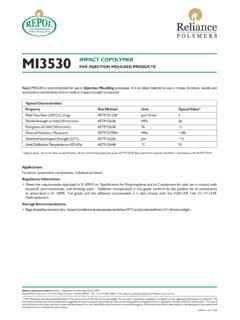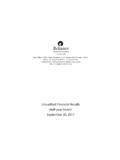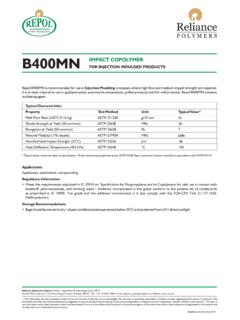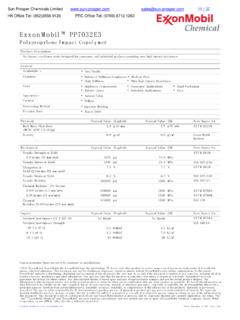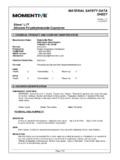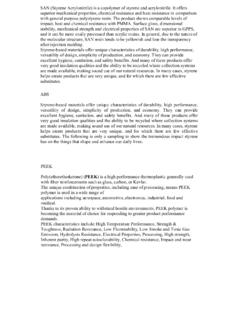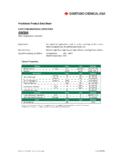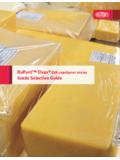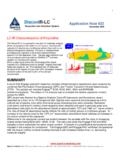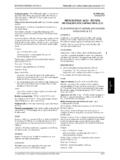Transcription of PRODUCT RISK ASSESSMENT - Reliance Industries
1 PRODUCT RISK ASSESSMENT . Name: CAS No. 9003-79-1. Polypropylene co polymer (PPCP). PRODUCT Overview: Polypropylene copolymer (PPCP) is a colorless, non flammable, non reactive solid with no odor. See PRODUCT Description. Polypropylene copolymer (PPCP) is usually stored and/or transported as 25 Kg Bags or 1. MT FIBC jumbo Bags. It is used in raw material for plastic Processing industry. Polypropylene copolymer (PPCP) is a non hazardous material and it's over exposure by short term or long term inhalation does not cause any harmful health effect. See Health Information. For handling and storage keep in cool and well ventilated place, Keep away from heat and sunlight RIL supports the sale of PPCP for use of plastics in Processing Industry only in industrial applications.
2 Please provide adequate ventilation when using the material and follow the principals of good occupational hygiene. See Exposure Potential. Not classified as dangerous for supply and use. See Physical Hazard Information. Release of dust to environment does not pose any threat. See Environmental Information. Manufacture of PRODUCT : Capacity: Worldwide capacity of Polypropylene (Homopolymer and copolymer ) in 2010 was in excess of 45 million metric tons. RIL produces million metric tones per annum. Process: Polypropylene copolymer (PPCP) is prepared by Gas Phase, Bulk phase and Slurry Phase Polymerization using Propylene and ethylene as feed stock & Heterogeneous Catalyst PRODUCT Description: Polypropylene copolymer (PPCP) is a colorless solid in granular form with no odor.
3 It is non-reactive with environment. PRODUCT Uses: Polypropylene copolymer (PPCP) is widely used in Plastic Processing Industry to Make variety of Products such as Packaging Films , sheet , Boxes , Containers, Bags, FIBC, Home Ware , Home Care , Personal Care & Hygiene Combs, Brushes, Medicals &. Surgical Equipments, Appliances, Automotives Furniture's, Industrial Products and article of day to day usage. Exposure Potential: Polypropylene copolymer (PPCP) is used as raw material for plastic processing industry. Based on the uses for Polypropylene copolymer (PPCP), the public could be exposed through: Workplace Exposure: Exposure can occur either in manufacturing facility or in the various industrial or manufacturing facilities that use Polypropylene copolymer (PPCP).
4 It is produced, distributed, stored and consumed in closed systems. Those working with Polypropylene copolymer (PPCP) in manufacturing operations could be exposed to dust during maintenance, sampling, testing, or other procedures. In some cases, dust scrubbers, filters or engineering modifications to the process equipment will be necessary to reduce emissions to acceptable Health Information. Consumer Exposure To RIL PRODUCT : Polypropylene copolymer (PPCP) is used as a raw material in the manufacture of plastic products. RIL does not sell Polypropylene copolymer (PPCP) for direct consumer use.
5 RIL supports the sale of Polypropylene copolymer (PPCP) only for use in industrial applications and will not knowingly sell into unsupported applications. Direct consumer exposure to RIL Polypropylene copolymer (PPCP) is unlikely. Environmental Releases: The PRODUCT is non-biodegradable. In the event of spillage, ensure suitable personal protection including respiratory protection during removal of spillage. Spillages may be slippery. Avoid release to environment. Do not allow to drains, sewers or watercourses. Sweep up and shovel into waste drums or plastic bags. Dust clouds are sensitive to ignition by electrostatic discharge.
6 Large Releases: The PRODUCT is non-biodegradable. Industrial spills or releases of PPCP are infrequent. If a large spill does occur, the material should be captured, collected, and reprocessed or disposed of according to applicable governmental requirements. Positive pressure, self-contained breathing apparatus (SCBA) with a full-face mask approved by NIOSH is recommended for emergency work. Eliminate all sources of ignition immediately. Environmental, Health, and Physical Hazard Information. In case of fire . Extinguishing Media: Extinguish preferably with foam, carbon dioxide or dry chemical.
7 Do not use water jet or water spray. Fire Fighting Protective Equipment: A self contained breathing apparatus and suitable protective clothing should be worn in fire conditions. Hazardous Decomposition PRODUCT (s): Combustion or thermal decomposition will evolve toxic and irritant vapors. Can melt and burn in a fire. Molten material tends to flow or drip and will propagate fire. See Physical Hazard Information. For more information, request the relevant Material Data Safety Sheet from RIL. Health Information: Polypropylene copolymer (PPCP) is non toxic non hazards material and can be considered as material safe for contact with humans and animals, Ingestion Low oral toxicity.
8 Polypropylene copolymer (PPCP): LD50 (rat) : >5000 mg/kg Inhalation: Low acute toxicity. Dusts and vapors or fumes evolved during thermal processing may cause irritation to the respiratory system. Skin Contact No evidence of irritant effects from normal handling and use. Eye Contact Dust may have irritant effect on eyes. Permanent damage is unlikely. Long Term Exposure chronic effects are unlikely. For more information, request the relevant Material Data Safety Sheet Environmental Information: Under normal conditions, PPCP exists as a solid granule. PPCP is susceptible to degradation by exposure to sunlight and moisture PPCP insoluble in water.
9 Floats on water. The PRODUCT has low mobility in soil. The PRODUCT is non-biodegradable. Low toxicity to aquatic organisms. Unlikely to affect biological treatment processes For more information, request the relevant Material Safety Data Sheet Physical Hazard Information: Polypropylene copolymer (PPCP) is a non-reactive PRODUCT , stable at ambient storage conditions. It does not decompose in the air and does not release any harmful gases or other products. Keep the PRODUCT in original container in a cool, ventilated place. No special precautions needed for handling and storage.
10 Can melt and burn in fire. Molten material tends to flow and will propagate fire. For more information, request the relevant Material Data Safety Sheet Regulatory Information: Regulations may exist that govern the manufacture, sale, transportation, use, and/or disposal of PP copolymer . These regulations may vary by city, state, country, or geographic region. Information may be found by requesting the Technical Data Sheet, or requesting the relevant Material Data Safety Sheet from RIL. Reference: National Institute for Occupational Safety and Health guide to chemical hazards and International Chemical Safety Cards (WHO/IPCS/ILO) and.


